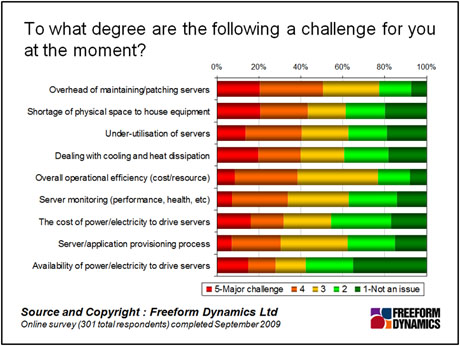April 1, 2010 was a not classic All Fools’ day in the UK press, although The Register did pull off a few half-decent pranks itself, including news of an alien invasion through the Large Hadron Collider in Switzerland. Now that the April Fools’ jokes have been exposed it should be safe to confirm something that wasn’t one – the “Carbon Reduction Commitment To Energy Efficiency Scheme”, which is now in force in the UK.
This mouthful was formerly known as “The Carbon Reduction Commitment”, or CRC to its friends, though there don’t seem to be too many of these in business. The impact over the next few years on the very large organisations covered by this directive and how they manage their electricity consumption may be profound. Will CRC actively influence just how much attention CIOs and data centre managers pay to their electricity meters?
As the figure below shows, we know from Reg readers that until now neither the cost of electricity to power data centres nor its availability are the top challenges faced by the majority of companies. That said, these matters are important concerns for over a third of enterprises, and if your organisation is one of the 5,000 covered by CRC it is likely that even more attention will be expended on electricity consumption.

The CRC will now force the largest enterprises to report every year on their use of energy and over time they will have to purchase ’carbon allowances in accordance with the scale of their carbon footprints. So clearly there will be a growing desire to reduce power consumption beyond the existing desire to save money on fuel bills.
But the CRC has another card to play – one that may hold greater sway than even the direct financial impacts of buying carbon allowances or trading excess allowances if a company does a great job reducing its CO2 footprint. CRC will also see a “league table” published showing how good a job each of the enterprises covered by the CRC is doing on carbon reduction.
It will be interesting to see whether organizations identify any advantage in being placed high in the published league tables or if they perceive there to be any PR problems with a low standing in the table.
While IT does consume a lot of electricity, especially in the very largest of organizations, we should not forget that in the vast majority of cases the IT power bill is a minute fraction of the total power bill. So while in many scenarios it is possible to make strong cost-benefit cases to introduce power-efficient servers to host ever-expanding business workloads, CRC also offers IT the opportunity to help its business users run the rest of its routine processes and operations more power efficiently.
We know that IT has many opportunities to help the rest of the business work more carbon-efficiently and several reports on this are available on Freeform Dynamics’ website. But unless the business puts in place monitoring tools that can link IT resource usage and electricity consumption with business use, there is a chance that some IT departments may be penalized for increasing their power draws even though they are materially helping lower the overall business footprint.
While there may be areas in server consolidation projects to replace older less power-efficient servers and storage with new systems, it’s important that IT departments see the bigger picture. In many organizations covered by CRC it is likely that they will be asked to do even more to help the business reduce its overall carbon footprint.
Clearly data centres will need to operate as power-efficiently as they can, but overall consumption should be allowed to increase – assuming that the data centre has the ability to draw in more electricity – if it helps the business as a whole to reduce its global footprint. And on this point some internal marketing may be needed as the possibility for IT to be blamed for increased electricity and carbon footprints clearly exists, unless everyone in the business is aware of just how IT is helping reshape the overall carbon footprint.
We should also recognize that while today CRC only covers around 5,000 very large UK-based organizations, there is every chance that its tendrils will spread over time.
If you are working in one of the organizations covered by CRC we would welcome your feedback on what effects, if any, CRC is having across your business, especially in the IT arena. If you are not directly affected by CRC, do you have the ability to monitor electricity consumption in your data centres or computer rooms? Do you know just how this helps the overall carbon footprint picture? Or are you just too busy keeping stuff going to care until the boss says so? Equally, has anybody put in place a monitoring system to give feedback specifically on the bureaucratic overhead (and possible carbon impact thereof) imposed by CRC reporting itself?


Have You Read This?
Generative AI Checkpoint
From Barcode Scanning to Smart Data Capture
Beyond the Barcode: Smart Data Capture
The Evolving Role of Converged Infrastructure in Modern IT
Evaluating the Potential of Hyper-Converged Storage
Kubernetes as an enterprise multi-cloud enabler
A CX perspective on the Contact Centre
Automation of SAP Master Data Management